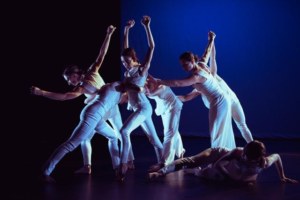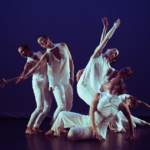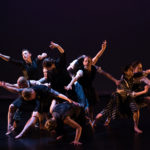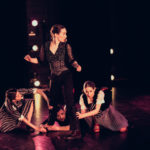Un-Still Life, with 3rd Law Dance
A preview by Betsy Schwarm
At first glance, still-life imagery and dance might seem contradictory ideas. After all, the essence of dance is motion, not stillness. However, a still-life image is essentially a moment in time: what about the next moment? What colors and textures might emerge from further consideration of that bowl of fruit, those pots of pansies, or those fabrics draped across that chair? They may not move, but surely they can suggest the possibility of motion.
That’s the concept behind the spring production to be presented this weekend (April 13/14/15) by Boulder-based 3rd Law Dance/Theater. Company artistic director Katie Elliott invited half a dozen of her colleagues to join her in choreographing dance scenes for a single program. The overall title Un-Still Life is one she and her co-director Jim LaVita had used previously in collaboration with jazz pianist/composer Art Lande and thought it was worth reviving. “Having a
theme,” Elliott says, “is a way to invite choreographers to fill the box. It gives them structure, but still offers freedom
The seven different choreographers – all dancers with 3rd Law, and some, on this occasion, taking their first steps into the art of choreography – were invited to think about colors, and different colors likely suggest different energies. Elliott herself chose to work with white, pointing out that, though in pigment, white is the absence of color, in light, it’s all colors together, which seems an ideal concept for an ensemble piece. Her colleagues made other choices: grey, orange, yellow, red, purple, and blue.
Each choreographer – Elliott herself, as well as Jamie Melaragno Schuler, Danielle Hendricks, Christine Rohde, Kat Gurley, Michelle Pugh, and Page Jenkins – drafted a short description of what that color meant to her and how she intended to evoke it in motion. They also made personal choices of music that seemed best suited to that individual’s impression of the chosen color; those musical selections will range from great masters of the past to intriguing talents of today. In the printed program, audience members will find specifics as to the music, as well as the choreographers’ descriptions of their visions. Spoken introductions will also be offered from the stage.
Admittedly, in the context of color, the idea of “meaning” is likely fluid. Orange may mean confidence to some observers, even as to others it represents a certain professional sports team. “Meaning,” Elliott maintains, “is created by viewers’ interpretation, as some images remind them of objects or experiences of personal significance.” She and her colleagues remind audience members to imagine that colors, like moods, are, in Elliott’s words, “not to be understood, but to be felt.” Feelings vary from person to person, just as colors – and even motions – speak to us in different ways. Elliott invites audience members to consider “what memories come to us when we look at a motion.”
It isn’t an evening of traditional story ballets, but, after all, that has never been the mission of 3rd Law. Any dance company that takes its name from physics and Sir Isaac Newton – his Third Law of Motion attesting that, for every action, there is an equal and opposite reaction – is clearly one that approaches dance in a new and mostly modern fashion. Elliott says she sees “different paths into choreography,” as well as different ways of expressing concepts in motion. As for still-life imagery, she notes that any such scene includes not only shapes and colors, but also the spaces between those shapes and colors. Some shapes, colors, and even spaces may suggest nervous action, others graceful flow: all of it comes together to create a varied tapestry of evolving textures.
Since architecture has been called frozen music, why not imagine dance as an un-frozen still-life? That this un-frozen image is abstract in concept frees not only the choreographers, but also the audience members. We aren’t told what it means, so we can make of the experience what we will. To borrow Newton’s phrase, audience members may have opposite reactions, but those reactions are yet equal. After the performance, try chatting with other attendees about their impressions: there should be plenty of food for thought.
3rd Law’s Un-Still Life program will be given at Boulder’s Dairy Arts Center, 2590 Walnut Street. Performances are scheduled for Friday, April 13, and Saturday, April 14, as well as Sunday, April 15. Friday and Saturday performances begin at 7:30pm; Sunday’s starts at 4pm. For further information, visit 3rd Law’s website: http://3rdlaw.org/works-w/upcoming.











